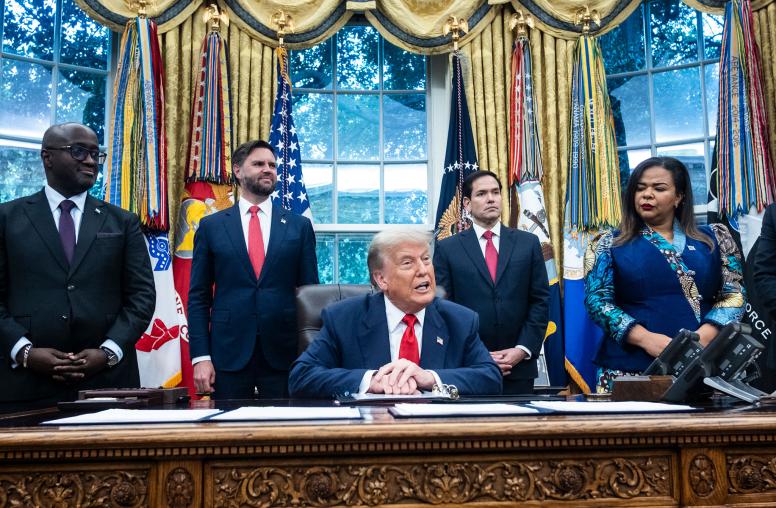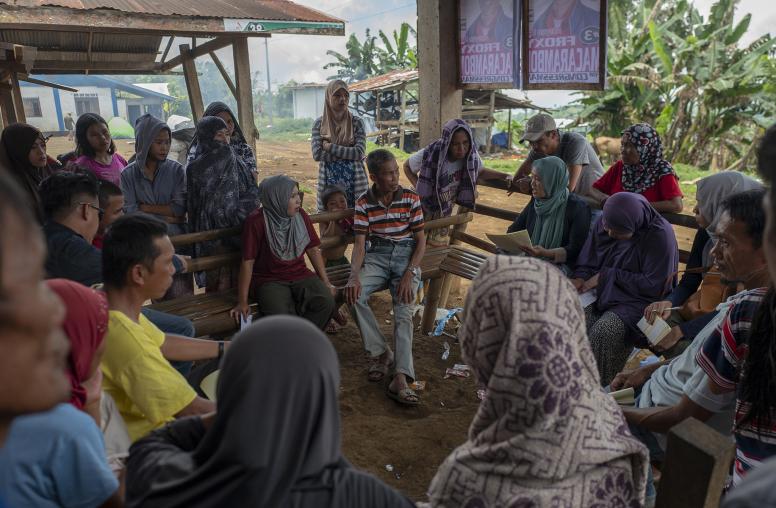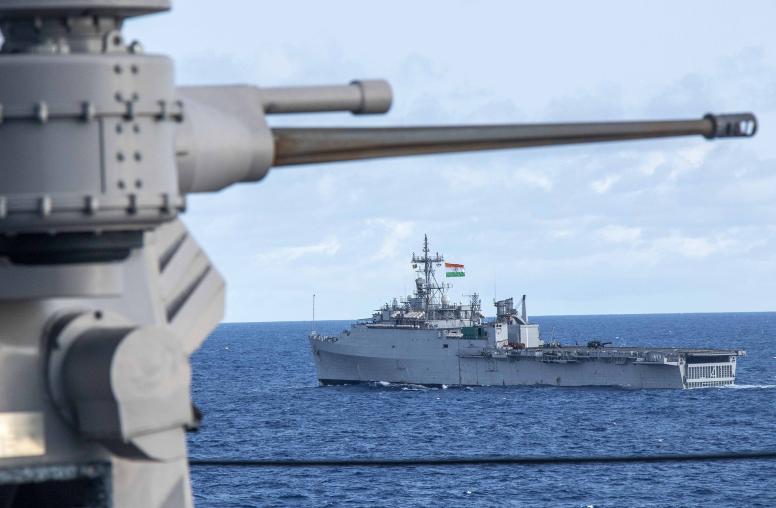2008-2009 Winning Essay - National First Place Winner
National First Place Winner
Sophia Sanchez
Ladue Horton Watkins High School
St. Louis, Missouri
Coordinator: Megan McCorkle
“Never again” has long been the somber declaration of those victimized by crimes against humanity. It bears with it the hope that the international community can learn from past atrocities and, in the words of the United Nations Charter, “save succeeding generations from the scourge of war.”1 However, a lack of cohesive international action has meant that genocide, torture, and other such acts continue to occur. Based on lessons learned from case studies of Somalia and Rwanda, the international community should prevent escalation of conflict by addressing its socioeconomic root causes, maintain a long-term peacekeeping force that utilizes a multilateral approach, and establish a localized administration system bolstered by a structure of accountability.
The Somali conflict stemmed from decades of political and ethnic unrest, which was intensified by the regime of Siad Barre. The northern Issaq clan resented Siad Barre’s 1969 seizure of power, which established an ethnically Marehan government.2 In 1988, the Somali National Movement (SNM), a primarily northern endeavor, began an insurrection against the Barre regime.3 On January 27, 1991, Siad Barre fled the capital to escape the northern assault, causing a power struggle between the former United Somali Congress members.4
By the end of 1992, over 300,000 Somalis had died from the conflict.5 Human Rights Watch expressed its outrage at seeing Somali refugees “undergoing traumatic suffering with apparently no end in sight.”6 The United Nations later labeled the systematic rape, displacement, and torture by rival clans in Somalia as crimes against humanity as defined in Article 7 of the Rome Statute of the International Criminal Court.7
While rhetoric was in no short supply among global actors, the humanitarian response to the crisis proved inadequate. Relief efforts were complicated by the loss of 60 percent of Somalia’s infrastructure and insufficient peacekeeping forces.8 From October to December of 1992, the World Food Programme anticipated sending 100,000 metric tons of food to Somalia, but only distributed 18,900 metric tons.9 UNOSOM (United Nations Operations in Somalia) concentrated its forces in Mogadishu while leaving positions in smaller settlements unfilled, effectively cutting off assistance to certain regions of Somalia.10
As the atrocities mounted, international actors began to withdraw altogether from Somalia. On October 3 and 4, 1993, eighteen American soldiers were killed during the Battle of Mogadishu.11 Faction leader Mohammad Aideed used these deaths to increase foreign discontent with the Somali operations and rid the country of peacekeeping forces.12 By March 31, 1994, all United States forces had evacuated Somalia.13 Lacking support, UNOSOM disbanded one year later, and Somalia became the epitome of a failed state and a failed international intervention.14
The violence in Rwanda resulted from prolonged ethnic tension that erupted after the assassination of Rwandan president Juvenal Habyarimana. After Hutus overthrew the Tutsi king in 1959, displaced Tutsis formed the Rwanda Patriotic Front (RPF) in Uganda.15 The RPF invaded Rwanda in 1990, marking the beginning of the civil war.16 Radio stations broadcast propaganda, urging Hutus to “exterminate the Tutsi cockroaches.”17 On April 6, 1994, President Habyarimana’s plane was shot down, an act the Hutus blamed on the Tutsis, and three months of genocide began.18
From April 6 to July 4, 1994, approximately 800,000 Rwandans were systematically murdered.19 Two million Rwandans fled to neighboring countries, where many ended up in disease-ridden refugee camps.20 On May 17, 1994, a UN Security Council resolution stated that “acts of genocide may have been committed,” but refrained from definitively labeling the Rwandan conflict “genocide.”21 As Vince Kern, director for African affairs and head of the Rwanda Task Force at the Pentagon, explained, “Genocide finding could commit [governments] to actually ‘do something.’ ”22 The genocide ended on July 4, 1994, when the RPF captured the capital city of Kigali, but Rwanda was left in ruins.23
Despite the international community’s knowledge of these atrocities, its response to the conflict in Rwanda proved woefully insufficient. A CIA report issued 20 days before Habyarimana’s assassination stated that 300,000 to 500,000 people could be killed if hostilities intensified.24 Clearly, the international community knew of the danger, but lacked a plan of action. Matters worsened when Hutu extremists murdered ten Belgians on April 7, 1994, prompting an international outcry.25 The United States closed its embassy, while the United Nations withdrew all but 270 UNAMIR (United Nations Assistance Mission for Rwanda) peacekeeping troops for the duration of the genocide.26
After the conflict ended, the international community implemented a tiered judicial system that worked toward lasting peace. An international tribunal presided over high-profile cases, while the localized Gacaca court system handled less serious offenders.27 The courts held trials in each village to not only prosecute defendants accused of genocide, but also to promote reconciliation through dialogue and community service.28 Such localized reintegration programs may be the key to quelling ethnic tension. For example, after the Gacaca system was implemented in Sovu, Rwanda, only 2 percent of residents agreed with the statement “I prefer to buy things from a shopkeeper of my own ethnicity.”29 The Gacaca approach was one of the successes of the Rwandan intervention, although much work remains to be done.
With the atrocities committed in Somalia and Rwanda in mind, international actors should subdue conflict by addressing socioeconomic root causes. On a financial level, the international community should work to stabilize depressed economies in at-risk nations. One way this might be achieved is through microfinancing, a small-scale investment program that effectively stimulated post-war Rwandan farming.30 The international community should also address social tensions by targeting hate radio, which was a large factor in escalating ethnic resentment in both Somalia and Rwanda.31 International law should permit the destruction of hate-radio transmitters when an agreed-upon code of conduct is broken.32 The global community must address economic and social root causes of conflict if it hopes to effectively prevent mass atrocities from occurring.
On the national level, governments such as the United States should establish an interagency Atrocities Prevention Committee (APC), as outlined by the Genocide Prevention Task Force.33 The APC should work with the United Nations, subregional organizations, NGOs, and individual nations to coordinate information concerning at-risk nations. The committee should establish a tiered warning system, based on factors such as institutional racism, history of conflict, media propaganda, and leadership instability. Reports such as the one that predicted 300,000 to 500,000 deaths in Rwanda should immediately trigger an ad hoc meeting at the presidential level to discuss policy options. With mass atrocities like the Rwandan genocide occurring in the time span of 100 days, it is imperative that international actors be prepared to take quick and decisive action to prevent their occurrence.
Should the conflict reach a point where preventive measures are no longer possible, international peacekeeping forces should commit themselves to rapid deployment and long-term stationing. The United Nations should plan for troop deployment in at-risk nations within 30 days of a Security Council resolution.34 In order to supply sufficient peacekeeping forces, international organizations should capitalize on subregional offers of assistance and support a civilian police force within war-torn countries. The key is to create a multilateral coalition that reflects global sentiments, not to establish western imperialism. These measures can work to drastically decrease response time and increase long-term peacekeeping capabilities by involving troops at the international, regional, and national levels.
Finally, the United Nations, United States, and other international actors should rely on a decentralized peacekeeping approach, rather than focusing on an urban headquarters. In order to increase dissemination of aid, staffing small towns should be a greater priority than establishing a headquarters in the capital.35 Global actors can garner local support by admitting regional leaders into intervention discussions. In northern Somalia, UNOSOM incorporated local elders into policy meetings, which increased clan willingness to cooperate with the United Nations in dismantling anarchistic factions.36 Placing a priority on local intervention personnel leads to better distribution of aid and more effective peace negotiations.
The judicial system for crimes against humanity should likewise be localized. The system should be modeled on the Rwandan Gacacas, assigning a court to each village. As more criminals are brought to justice, localized court systems demonstrate that war crimes will be punished. Dialogue between the accused and the victimized and a sentence involving community service should be key facets of the courts. A system of accountability similar to the one in Rwanda, in which 90 percent of the electorate voted for Gacaca judges, would ensure that local judges have the consent of the people and are not arbitrarily appointed.37 Moreover, the international community should establish sentencing guidelines, which would standardize punishments and guarantee a focus on reintegration, not retribution. By utilizing a localized judicial system, the international community can transition from a goal of short-term peace to long-term stability.
In the wake of the atrocities in Somalia and Rwanda, it is critical that the international community learn to better protect against crimes against humanity. By addressing the root causes of conflict, rapidly deploying a long-term peacekeeping force, and shifting to a localized administration approach, international actors can convert rhetoric into results. The process will not happen overnight, but by implementing these policies, the international community can begin to make “never again” a reality.
Notes
1. Goodrich, Leland Matthew, and Edvard Isak Hambro. Charter of the United Nations: Commentary and Documents. London: World Peace Foundation, 1949.
2. Sahnoun, Mohamed. Somalia: The Missed Opportunities. Washington, DC: United States Institute of Peace Press, 1994.
3. Brown, Michael E., and Richard N. Rosecrance. The Cost of Conflict: Prevention and Cure in the Global Arena. Lanham, MD: Rowman & Littlefield, 1999.
4. Sahnoun. Somalia.
5. Bush, George. “Humanitarian Crisis in Somalia.” Lettter from President Bush to the Speaker of the House and President Pro Tempore of the Senate. Washington, DC, December 10, 1992.
6. "Human Rights Watch World Report 1993—Somalia." Human Rights Watch. January 1, 1993. Accessed January 20, 2009. http://www.unhcr.org/refworld/docid/467fca601e.html
7. Rishmawi, Mona. "Situation of Human Rights in Somalia." UN Commission on Human Rights, Geneva. April 22, 1999.
8. "Somalia—UNOSOM I." United Nations Operations in Somalia I . March 21, 1997. Accessed 23 January 2009. http://www.un.org/Depts/DPKO/Missions/unosomi.htm
9. Sahnoun. Somalia.10. Ibid.
11. Smith, Michael. Killer Elite: The Inside Story of America's Most Secret Special Operations Team. New York: St. Martin's, 2007.
12. Kaempf, Sebastian. “Somalia and General Aideed's Strategic Response to U.S. Intervention: Invoking America's Experiences in Lebanon and Vietnam.” Paper presented at the nnual meeting of the International Studies Association, Chicago, IL, 2007.
13. Copson, Raymond W. Africa's Wars and Prospects for Peace. New York: M. E. Sharpe, 1994.
14. Peterson, Scott. Me against My Brother: At War in Somalia, Sudan, and Rwanda. New York: Routledge, 2000.
15. Cohen, Jared. One Hundred Days of Silence: America and the Rwanda Genocide. Lanham, MD: Rowman & Littlefield, 2007.
16. Ibid.
17. Sutton, Barbara, Sandra Morgen, and Julie Novkov. Security Disarmed: Critical Perspectives on Gender, Race, and Militarization. Piscataway, NJ: Rutgers University Press, 2008.
18. Khan, Shaharyar M., and Mary Robinson. The Shallow Graves of Rwanda. New York: I. B. Tauris, 2000.
19. Barnett, Michael. Eyewitness to a Genocide: The United Nations and Rwanda. Ithaca, New York: Cornell University Press, 2002.
20. "Rwanda: Accountability for War Crimes and Genocide." Special Report, January 1995. United States Institute of Peace. Accessed January 20, 2009.
http://www.usip.org/pubs/specialreports/early/rwanda1.html
21. "Timeline: 100 Days of Genocide." BBC News, April 6, 2004. AccessedJanuary 21, 2009.
http://news.bbc.co.uk/2/hi/africa/3580247.stm
22. Kern, Vince. Discussion paper. Office of the Deputy Assistant Secretary of Defense for Middle East/Africa Region. Washington, DC: U.S. Government Printing Office, November 18, 1998.
23. Cohen, Jared. One Hundred Days of Silence: America and the Rwanda Genocide. Lanham, MD: Rowman & Littlefield,2007.
24. Ibid.
25. Barnett, Michael. Eyewitness to a Genocide: The United Nations and Rwanda. Ithaca, NY: Cornell University Press, 2002.
26. Ibid.
27. Drumbl, Mark A. Atrocity, Punishment, and International Law. New York: Cambridge University Press, 2007.
28. Ibid.
29. Rettig, Max. "Gacaca: Truth, Justice, and Reconciliation in Postconflict Rwanda?" African Studies Review 51 (2008): 25¬–50.
30. Wilson, Tamsin. "Microfinance during and after Armed Conflict: Lessons from Angola, Cambodia, Mozambique, and Rwanda.” Concern Worldwide and the Springfield Centre for Business in Development. March 2002. AccessedJanuary 22 2009. http://www.microfinancegateway.org/files/14563_14563.pdf
31. Adelman, Howard, and Astri Suhrke. The Path of a Genocide: The Rwanda Crisis from Uganda to Zaire. New Brunswick, NJ: Transaction, 2000.
32. As suggested in Allan Thompson and Kofi Annan. The Media and the Rwanda Genocide. Ann Arbor, MI: Pluto, 2007.
33. Albright, Madeleine K., and William S. Cohen, co-chairs. Preventing Genocide: A Blueprint for U.S. Policymakers. Genocide Prevention Task Force. United States Holocaust Memorial Museum, American Academy of Diplomacy, and United States Institute of Peace. 2008. Accessed January 21, 2009. http://www.usip.org/genocide_taskforce/pdf/FINAL%20REPORT.pdf
34. As suggested in Lakhdar Brahimi, chairman. Report of the Panel on United Nations Peace Operations. New York: United Nations, 2000.
35. Sahnoun. Somalia.
36. Ibid.
37. Brown, Jane. "Rwanda—Gacaca." Center for Communication Programs, John Hopkins University. 2005. Accessed January 19, 2009.
http://www.jhuccp.org/africa/rwanda/gacaca.shtml
Bibliography
Print Sources
Adelman, Howard, and Astri Suhrke. The Path of a Genocide: The Rwanda Crisis from Uganda to Zaire. New Brunswick, NJ: Transaction Publishers, 2000.
Barnett, Michael. Eyewitness to a Genocide: The United Nations and Rwanda. Ithaca, NY: Cornell University Press, 2002.
Brahimi, Lakhdar, chairman. Report of the Panel on United Nations Peace Operations. New York: United Nations, 2000.
Brown, Michael E., and Richard N. Rosecrance. The Cost of Conflict: Prevention and Cure in the Global Arena. Lanham, MD: Rowman & Littlefield , 1999.
Bush, George. “Humanitarian Crisis in Somalia.” Lettter from President Bush to the Speaker of the House and President Pro Tempore of the Senate. Washington, DC, December 10, 1992.
Cohen, Jared. One Hundred Days of Silence: America and the Rwanda Genocide. Lanham, MD: Rowman & Littlefield, 2007.
Copson, Raymond W. Africa's Wars and Prospects for Peace. New York: M. E. Sharpe, 1994.
Drumbl, Mark A. Atrocity, Punishment, and International Law. New York: Cambridge University Press, 2007.
Goodrich, Leland Matthew, and Edvard Isak Hambro. Charter of the United Nations: Commentary and Documents. London: World Peace Foundation, 1949.
Kaempf, Sebastian. “Somalia and General Aideed's Strategic Response to U.S. Intervention: Invoking Americas Experiences in Lebanon and Vietnam.” Paper presented at the annual meeting of the International Studies Association. Chicago, IL, 2007.
Kern, Vince. Discussion paper. Office of the Deputy Assistant Secretary of Defense for Middle East/Africa Region. Washington, DC: U.S. Government Printing Office, November 18, 1998.
Khan, Shaharyar M., and Mary Robinson. The Shallow Graves of Rwanda. New York: I. B. Tauris, 2000.
Peterson, Scott. Me against My Brother: At War in Somalia, Sudan, and Rwanda. New York: Routledge, 2000.
Rettig, Max. "Gacaca: Truth, Justice, and Reconciliation in Postconflict Rwanda?" African Studies Review 51 (2008): 25–50.
Rishmawi, Mona. "Situation of Human Rights in Somalia." UN Commission on Human Rights, Geneva. April 22, 1999.
Sahnoun, Mohamed. Somalia: The Missed Opportunities. Washington, DC: United States Institute of Peace Press, 1994.
Smith, Michael. Killer Elite: The Inside Story of America's Most Secret Special Operations Team. New York: St. Martin's, 2007.
Sutton, Barbara, Sandra Morgen, and Julie Novkov. Security Disarmed: Critical Perspectives on Gender, Race, and Militarization.
Piscataway, NJ: Rutgers University Press, 2008.
Thompson, Allan, and Kofi Annan. The Media and the Rwanda Genocide. Ann Arbor, MI: Pluto, 2007.
Internet Sources
Albright, Madeleine K., and William S. Cohen, co-chairs. Preventing Genocide: A Blueprint for U.S. Policymakers. Genocide Prevention Task Force. United States Holocaust Memorial Museum, American Academy of Diplomacy, and United States Institute of Peace. 2008. Accessed January 21, 2009. http://www.usip.org/genocide_taskforce/pdf/FINAL%20REPORT.pdf
Brown, Jane. "Rwanda—Gacaca." Center for Communication Programs, John Hopkins University. 2005. Accessed January 19, 2009. http://www.jhuccp.org/africa/rwanda/gacaca.shtml
"Human Rights Watch World Report 1993—Somalia." January 1, 1993. Human Rights Watch. Accessed January 20, 2009. http://www.unhcr.org/refworld/docid/467fca601e.html
"Rwanda: Accountability for War Crimes and Genocide." Special Report, January 1995. United States Institute of Peace. Accessed January 20, 2009. http://www.usip.org/pubs/specialreports/early/rwanda1.html
"Somalia—UNOSOM I." United Nations Operations in Somalia I. March 21, 1997. Accessed January 23, 2009. http://www.un.org/Depts/DPKO/Missions/unosomi.htm
"Timeline: 100 Days of Genocide," BBC News, April 6, 2004. Accessed January 21, 2009.
http://news.bbc.co.uk/2/hi/africa/3580247.stm
Wilson, Tamsin. "Microfinance during and after Armed Conflict: Lessons from Angola, Cambodia, Mozambique and Rwanda.” Concern Worldwide and the Springfield Centre for Business in Development. March 2002. Accessed January 22, 2009. http://www.microfinancegateway.org/files/14563_14563.pdf




